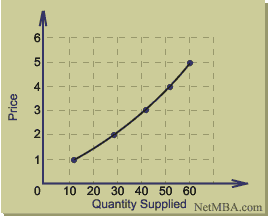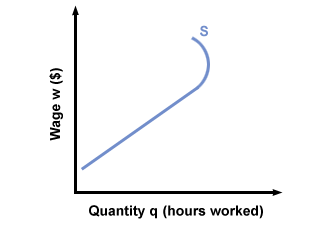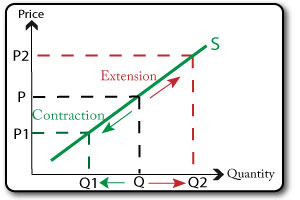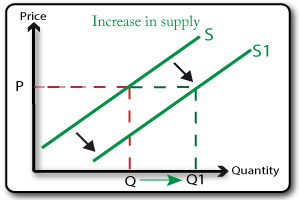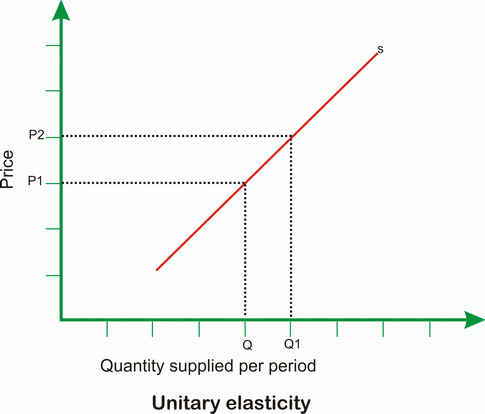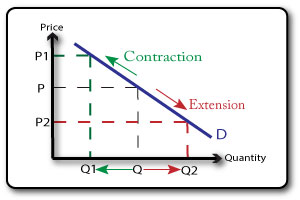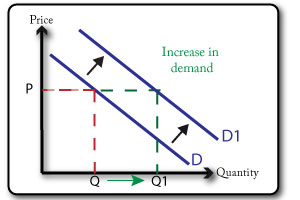Supply refers to the various amounts of a good which the sellers are willing and able to sell at any given price per unit of time.
Factors Influencing Supply (Determinants of Supply)
1. Price of that commodity :
Higher the price, more will be the quantity supplied.
2. Price of other commodities :
The relative profitability of other commodities affects the relative attractiveness to firms for different line of production. Firms undertake to supply new commodity with high profitability.
3. Goals of the producers:
Firms may select more commodities for supply, based on their goal to expand the market, serve the interest of the society etc. For this study we, however, consider profit maximization as the single important goal of the firms.
4. State of Technology:
The improvement in the technique of production
essentially leads to increase in supply. Inventions
and innovations make it possible to produce more
and/or better commodities.
5. Cost of production:
If the cost of production factors increases the
producer decides to produce less and supply of that
commodity is restricted and vice versa. Here it is
assumed that other things being equal.
6. Availability of raw materials & other inputs:
Supply is adversely affected in absence of free and
regular availability of required amounts of raw
materials and other inputs.
7. Climate and forces of nature:
Especially in the sphere of agriculture, climate
plays a major role in supply. Both timing & quantum
of rains have direct effect on supply of food
grains, fruits and other farm or animal products.
8. Time element:
In a short period, supply cannot be changed to
match change in demand or price. With change in
prices or demand supply gets adjusted after a
certain period that is required to readjust inputs,
capacity or process of production.
9 Transport Facilities:
Availability of transport facilities enhances
supply and enlarges the markets for a commodity.
10 Taxation and subsidy:
The tax policy of the Government influences
‘production initiative’ of entrepreneurs and prices
for commodities. Both have direct effect on supply.
11 Expectations regarding future prices:
These lead to either speculative hoarding ( less
supply) or even distress sales. ( more supply).
The Supply Function :
As the quantity supplied of commodity X is a
function of about eleven variables listed above,
the function can be written as
Qxs =f(Px,p,c,G,T,....etc)
Where,
Px is price of X
P is price of commodities other than X
c is cost of production.
G is goals of he producers etc.
As this is a complex functional relationship, we
assume that all the other variables are held
constant and establish relation between Price of X
and Quantity supplied of X.
Or
Qxs =f(Px)
where,
P1 =P0; c=c0; G=G0;etc.
The Law of Supply :
As stated above the law of demand assumes factors
other than price of commodity remain constant.
The law states “other things remaining the same the
quantity supplied of a commodity X is directly
related to its price.”
The Supply Curve :
Supply schedule indicates different quantities of
commodity X supplied at various prices. When these
are plotted on a graph we get a supply curve as
below. This curve slopes upwards from left to right
indicating the direct relationship.
It is customary to represent price on Y axis and
quantity on the X axis.
What are other things that must remain the same ?
Other things that must remain the same are :-
- Cost of production.
- Methods of production.
- Availability of inputs.
- Transport facilities.
- Weather conditions.
- Tax structure.
- Goals of producers.
- Sellers’ expectations about future prices.
-
Backward Bending Supply Curve of labour :-
An interesting exception to the law of supply is
provided by the supply curve of labour. Here we
come across a peculiar phenomenon. As wages
increase, labour supply in the form of hours worked
per day goes up; but only up to a certain point,
say 12 hours. After reaching that point worker,
finds that same wages could be earned, by working
lesser hours at the increased rate. Thereafter the
supply reduces. This is called backward bending
supply curve of labour and is an exception to the
law of demand.
Reservation Price and Supply :
The reservation price of a seller is that price
below which the seller would not sell the
commodity. The seller wants to guard his profit
margin.
The reservation price of a seller depends on –
► The sellers need for liquid cash.
If the seller wants cash urgently, his reservation
price would be low as he needs to convert the goods
into cash urgently.
► The durability of commodity.
If the commodity is perishable, the reservation
price would be low as seller needs to convert goods
into cash in a short time.
► The expectations about future price.
If the seller expects that the prices would rise in
future, he would increase his reservation price and
vice versa.
► The cost of storage.
High cost of storage would make seller to dispose
off his stocks early, thereby bringing down the
reservation price.
Variations and changes in Supply :
(Movements along the curve vs. shifts of curves)
If we consider changes in price of a commodity as
the only factor influencing its quantity supplied,
then we experience movements on the same curve. We
either have extension or contraction of supply.
Movement along the Supply Curve (Price)
A change in price causes a movement along the curve The higher the price of a product, the more suppliers will produce.. If the price rises then supply will rise, this is known as an extension in supply. The lower the pice of a product the less will be supplied. If the price falls then supply will fall, this is known as an contraction in supply.
On the other hand when factors other than price of
the commodity influence supply for that commodity,
then we have either increase or decrease in supply
shown by complete shifts in the supply curve.
Shift of the Supply Curve
A shift of the supply curve represents an increase or decrease in the quantitiy supplied at each & every price. Causes of shifts in supply:
- Improvements in technology (increase efficiency & reduce costs).
- Weather, climate and disease (especially agricultural products).
- Taxes and subsidies can make the costs of production more/less expensive and therefor increase or decrease supply.
- Natural disasters & wars can severly disrupt supply.
- Resources: discoveries of new resources or depleting reserves of resources can affect the supply of products.
Elasticity of Supply
In economics price elasticity of supply means the
degrees of responsiveness of quantity supplied of
commodity X to the change in price of X itself.When price of X changes, supply for it may change
either proportionately; more or less than
proportionately; or may not change at all. These
changes can be expressed in %s as under
Es = % change in Quantity supplied of X
_______________________________________
% change in Price of X
Thus price elasticity of supply is the ratio of
percentage change in quantity supplied of X to
percentage change in price of X.
Therefore,
%ΔQsx
Es = ________
%ΔPx
Or mathematically it can also be expressed as
P ΔS
Es= __ x ___
S ΔP
Five Types of Elasticities of Supply - Es :
1. Unit Elastic Supply
Supply is said to be unit elastic when elasticity
of supply is = 1. Then any change in price brings
about exactly proportionate change in quantity
supplied.
2. Relatively Inelastic Supply
Supply is said to be Relatively Inelastic when
elasticity of supply is < 1. Then any change in
price of commodity X, brings about less than
proportionate change in quantity of X supplied.
3. Relatively Elastic Supply
Demand is said to be Relatively Elastic when
elasticity of supply is > 1. Then any change in
price of commodity X, brings about more than
proportionate change in quantity of X supplied.
4. Perfectly Inelastic Supply
Supply is said to be Perfectly Inelastic when
elasticity of supply is = 0. Then any change in
price of commodity of X brings about no change in
quantity supplied.
5. Perfectly Elastic Supply
Supply is said to be Perfectly Inelastic when
elasticity of supply is = α. Then any negligible
change in price of commodity X. brings about
infinite change in quantity of X supplied.
All five types of elasticities of supply can be
shown by different slopes of supply curve.
► Unitary elasticity of supply
Change in price from OP1 to OP2 brings
less than proportionate change in quantity
supplied from OQ to OQ1.
► Relatively Inelastic Supply
Change in price from OP to OP1 brings less than proportionate change in quantity supplied from OQ to OQ1.
► Relatively Elastic Supply
Change in price
brings more than proportionate
change in quantity supplied.
► Perfectly Inelastic Supply
Change in price brings no change in
quantity supplied.
► Perfectly Elastic Supply
Negligible change in price
brings infinite change in quantity
supplied.
Time Element and Supply
Economist Marshall assigned considerable importance
to time in the determination of supply. He stated
that demand reacts to a price change immediately.
But supply takes some time to adjust to price and
demand changes. Supply today is a function of
price prevailing in the immediate past.
Depending upon the period of time, supply can
adjust itself either partly or fully or not at all
to the change in demand and price; and will in turn
influence price. For supply to adjust to the
changes factors of production and process have to
be readjusted or investments increased. This
requires certain time.
Marshall has classified time into four categories.
♠ Very short period:
In this short time supply cannot adjust to change
in demand.
♠ Short period:
In this short time available, supply can adjust
partly to the change in demand by adding
(only) variable factors of production towards
supply.
♠ Long period:
In the long period, supply can adjust more fully to
the change, as adequate time is available to add
both variable and fixed factors of production
and/or increase capacity.
♠ Very long Period:
Nothing is certain about demand and supply in the
long period. Keynes said, “in the long period we
are dead”
Time element plays an important role in the theory
of price through its influence on supply.
